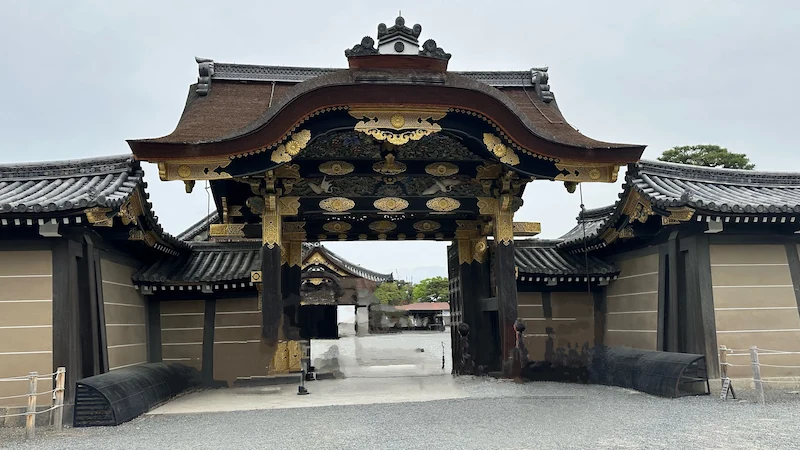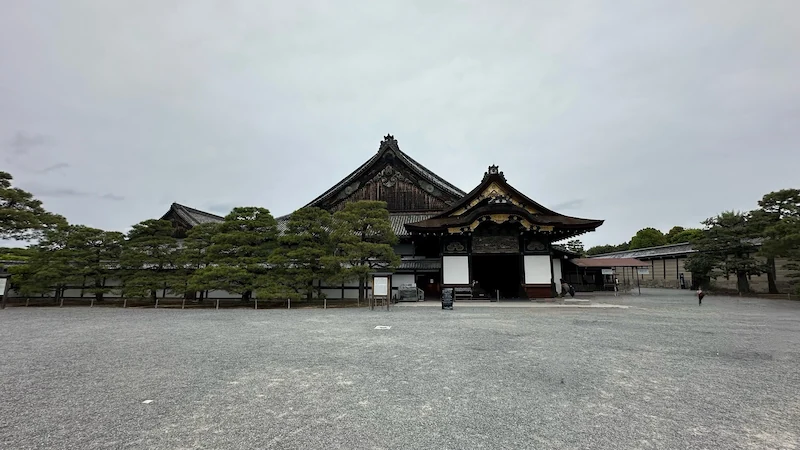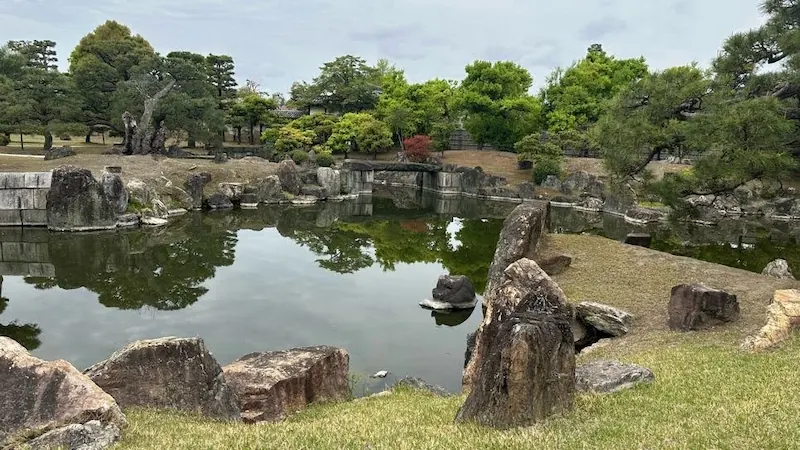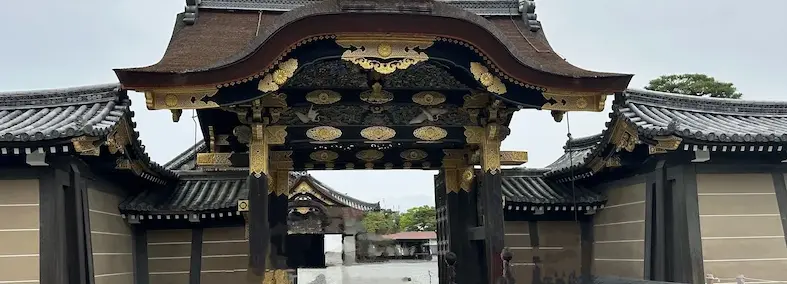The Ceremonial Gate That Welcomed the Emperor: Karamon
Nijo Castle’s iconic trio—“Karamon,” “Ninomaru Palace,” and “Ninomaru Garden”—preserves the pinnacle of Edo shogunal authority and aesthetic brilliance.
The vividly colored Karamon was refined to receive imperial processions; the lavish Ninomaru Palace supported the shogun’s statecraft; and the strolling garden, grounded in the Horai immortality ideal, is the only surviving example integrated with a shoin-style palace. Together, they immerse visitors in the depths of Edo-period beauty and power.
Karamon

🏛 Overview
The Karamon, serving as the grand gate to the Ninomaru Palace, was created for Emperor Go-Mizunoo’s visit in 1626 (Kanei 3). This four-post gate features a gabled cypress-bark roof (hinoki-buki) with karahafu (undulating gables) on both front and back. It is richly adorned with polychrome carvings and gilt metal fittings. Motifs such as “pine, bamboo, and plum with cranes” symbolizing longevity, and guardian karajishi (Chinese lions) protect the sacred precinct—an exuberant display of Momoyama splendor.
In 2013, conservation work renewed the cypress-bark roofing, re-gilded the decorative fittings, restored colors on carved transoms, and refinished the lacquer.
| Item | Details |
|---|---|
| Year Built | 1626 (Kanei 3), prepared for Emperor Go-Mizunoo’s visit |
| Builder | Unknown (likely commissioned by the shogunate) |
| Structure & Features | Four-post gate; gabled form; cypress-bark roof. Karahafu on both front and rear. Polychrome carvings and gilt fittings depicting motifs such as pine–bamboo–plum, cranes, karajishi (guardian lions), butterflies, etc. Designed as a sumptuous, high-prestige front gate. |
| Repairs & Restoration | Roof restored to cypress-bark in the Meiji era. Comprehensive conservation completed in 2013 (re-roofing with cypress bark, re-gilding, recoloring of carved transoms, lacquer refinishing). |
| Current Status | Extant; open as the front gate to the Ninomaru Palace. Designated an Important Cultural Property of Japan. |
| Loss/Damage | No record of major loss. Some documents indicate a temporary relocation in 1627. |
| Cultural Property | Important Cultural Property of Japan (“Karamon”). |
| Notes | Carved motifs are thought to embody prayers for the castle’s protection and prosperity. |
📍 Location
541 Nijojo-cho, Nijo-dori Horikawa Nishi-iru, Nakagyo-ku, Kyoto 604-8301, Japan
🚶 Access
About 1 minute (≈76 m) from the South Gate.
⏳ Suggested Time
- Quick highlights: about 10 minutes
- Deeper visit: about 30 minutes (to study carvings and ornament in detail)
🔍 Highlights
- Exquisite carvings: Transoms feature auspicious motifs—cranes and turtles with pines, dragons and tigers, and karajishi—all rendered in vivid polychromy that makes the entire gate gleam.
- Gilt metalwork: Gold-leafed fittings accentuate the gate’s grandeur.
- Historical find: During conservation, Tokugawa’s triple-hollyhock crest (aoi-mon) was discovered beneath chrysanthemum crests, evidencing the shift from Tokugawa to imperial ownership in the Meiji era.
💡 Trivia
- Immortal Huang An: Among the decorations is the immortal Huang An riding a turtle—an emblematic wish for the shogunate’s longevity.
- One of Japan’s “Three Great Karamon”: Nijo Castle’s Karamon is often listed alongside Kyoto Imperial Palace’s Kenrei-mon and Nikko Toshogu’s Yomei-mon.
Ninomaru Palace

🏛 Overview
The Ninomaru Palace symbolized Tokugawa authority, serving for shogunal lodging, ceremonies, and governance. A quintessential early Edo shoin-zukuri complex—and the only castle-palace that still survives—it boasts Kano-school mural screens, intricate transom carvings, and lavish metal fittings throughout.
| Item | Details |
|---|---|
| Year Built | Major works completed in the early Edo (Kanei) period |
| Builder | Tokugawa Shogunate (by shogunal order) |
| Structure & Features | A group of palatial buildings in shoin style. Six main components: Tozashu (Retainers’ Hall), Shikidai (Ceremonial Antechamber), Ohiroma (Great Hall), Sotetsu-no-ma (Sago Palm Room), Kuro-shoin (Black Study), and Shiro-shoin (White Study). Roofs and gables overlap in a staggered (goose-line) plan. Features “upper dais” rooms, alcoves, shelves, shoin windows, and a bedchamber framework; walls and doors carry Kano-school paintings, transom carvings, metal fittings, and polychrome ceilings. |
| Repairs & Restoration | Great renovations for the 1626 imperial visit. Damaged in the 1662 earthquake and repaired. Subsequent repairs followed fires, lightning, and late-Edo turmoil. |
| Current Status | Extant: approx. 33 rooms; footprint ≈ 3,300 m²; over 800 tatami mats. Designated a National Treasure and open to the public. |
| Loss/Damage | Struck by the 1750 lightning fire that destroyed the tenshu; parts of Ninomaru buildings also suffered in the 1788 Great Fire. |
| Cultural Property | National Treasure (all six Ninomaru Palace sections designated in 1952). |
| Notes | An exceptionally rare surviving castle-palace. |
📍 Location
541 Nijojo-cho, Nijo-dori Horikawa Nishi-iru, Nakagyo-ku, Kyoto 604-8301, Japan
🚶 Access
About 1 minute on foot (≈40 m) after passing through the Karamon.
⏳ Suggested Time
- Quick highlights: about 30 minutes
- Deeper visit: about 60 minutes (to study the rooms’ decoration and historical background)
🔍 Highlights
- Tozashu (Retainers’ Hall): The largest building in the palace where visitors waited. Tiger paintings on sliding doors and walls give it the nickname “Tiger Room,” projecting Tokugawa power.
- Ohiroma (Great Hall): The stage for formal audiences and rituals, lavishly decorated.
- Kuro-shoin & Shiro-shoin: Private wings—Kuro-shoin for affairs of state; Shiro-shoin as living quarters.
- Nightingale floors: Floorboards chirp as you walk, a built-in security feature to detect intruders.
💡 Trivia
- Backdrop to the Taisei Hokan: In 1867 (Keio 3), the 15th shogun Tokugawa Yoshinobu expressed his intention to restore governing authority to the Emperor here—marking a pivotal historical shift.
- Preservation of mural screens: Some original Kano-school works are housed in a repository for conservation, with replicas displayed in situ.
- Closed days: The Ninomaru Palace is closed on Tuesdays in July, August, December, and January, and from Dec 26 to Jan 3.
Ninomaru Garden

🏛 Overview
Ninomaru Garden is a signature Japanese garden within Nijo Castle and a celebrated example of the shoin-style garden. It is a strolling pond garden featuring a central Horai Island, with Crane and Turtle Islands to either side—an expression of Daoist Horai ideals of immortality and longevity. The garden is designed to be admired from three directions—Ohiroma (Great Hall), Kuro-shoin, and the Gyoko Palace—offering beautiful, distinct compositions from each vantage.
| Item | Details |
|---|---|
| Year Built | Early Edo period; likely developed alongside the Ninomaru Palace |
| Builder | Tokugawa Shogunate (as part of palace works) |
| Structure & Features | Strolling pond garden. Hills, stepping stones, tsukiji walls, and plantings arranged around the central pond. Composed as an integrated scene with the palace. Records indicate the grounds once hosted the Gyoko Palace (imperial lodging). |
| Repairs & Restoration | While detailed ledgers are limited, the garden has undergone maintenance from early modern times into the modern era to reach its present form. |
| Current Status | Extant and open to the public; preserved together with the palace architecture. |
| Loss/Damage | No record of complete destruction; no confirmation of major war/fire damage. |
| Cultural Property | Designated a Special Place of Scenic Beauty (1953). |
| Notes | Sources note that an imperial lodging once stood on the garden site. The castle’s overall plan integrates garden, palace, and Karamon. Chronologies record Special Scenic designation in 1953. |
📍 Location
541 Nijojo-cho, Nijo-dori Horikawa Nishi-iru, Nakagyo-ku, Kyoto 604-8301, Japan
🚶 Access
About 2 minutes on foot (≈130 m) from the Ninomaru Palace.
⏳ Suggested Time
- Quick highlights: about 15 minutes
- Deeper visit: about 30 minutes (to explore composition and history)
🔍 Highlights
- Horai and Crane–Turtle Islands: The central Horai Island flanked by Crane and Turtle Islands symbolizes immortality and longevity.
- Waterfall rockwork: On the west side of the Great Hall, a stone composition evokes a waterfall, adding motion to the scene.
- Stone placements: Tall, vertical stones impart a powerful, upright rhythm.
- Seasonal plantings: Cherry blossoms and azaleas in spring; autumn foliage later in the year—each season offers a new face.
💡 Trivia
- “Garden of the Eight Battle Arrays”: Ninomaru Garden is also nicknamed for its stone arrangements inspired by classic battle formations.
- The only surviving shoin-style palace garden: Ninomaru Garden is widely regarded as the sole extant example where a shoin-style palace and garden survive together.
- Designed for multi-angle viewing: Composed to be appreciated from Kuro-shoin, the Great Hall, and the former Gyoko Palace—each offering a distinct tableau.




comment